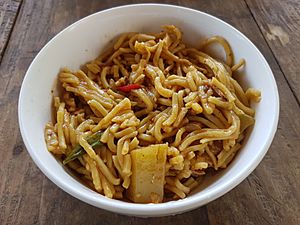Odong facts for kids

Odong guisado
|
|
| Alternative names | Pancit odong, Udong, Pancit udong |
|---|---|
| Place of origin | Philippines |
| Region or state | Davao Region, Visayas |
| Serving temperature | Hot |
| Main ingredients | Flour noodles, canned sardines with tomato sauce, bottle gourd, loofah, other vegetables |
| Variations | Odong guisado |
Odong, also called pancit odong, is a tasty noodle soup from the Visayas region of the Philippines. It's a popular and simple meal, especially in the Davao Region of Mindanao and the Visayas. This dish is famous for its special round flour noodles and a rich broth made with canned sardines in tomato sauce.
Contents
What's in Odong?
Odong is made with unique odong noodles. The main ingredients usually include:
- Canned smoked sardines (called tinapa) in tomato sauce
- Vegetables like bottle gourd (upo) and loofah (patola)
- Other vegetables such as chayote, ginger, garlic, and red onions
The soup is often spiced up with black pepper, scallions, toasted garlic, calamansi (a type of lime), or labuyo chili peppers.
Odong Guisado
While Odong is usually served as a soup, it can also be cooked with very little water. When prepared this way, it becomes a stir-fried noodle dish known as odong guisado.
How is Odong Eaten?
Odong is a common and affordable meal in the southern Philippines. It is almost always eaten with plain white rice. It's rare for people to eat Odong by itself.
Where Do Odong Noodles Come From?
The dish gets its name from the special round flour noodles called odong. These noodles are similar in texture and taste to Okinawa soba noodles. You can usually find them sold dried as straight sticks, about 6 to 8 inches (15 to 20 cm) long.
The name odong comes from the Japanese udon noodles. However, Odong dishes do not actually use udon noodles and don't look like traditional udon dishes.
History of Odong Noodles
Odong noodles first came from the Davao Region in Mindanao. In the early 1900s, many Japanese people lived there. The original odong noodles were made locally by people from Okinawa, Japan. Today, most odong noodles are a distinct yellowish color and are imported from China.
Noodle Substitutions
Sometimes, it can be hard to find odong noodles in other parts of the Philippines. If you can't find them, you can use other types of noodles instead. Common substitutes include:
- Misua
- Miki (egg noodles)
- Udon
- Even instant noodles

